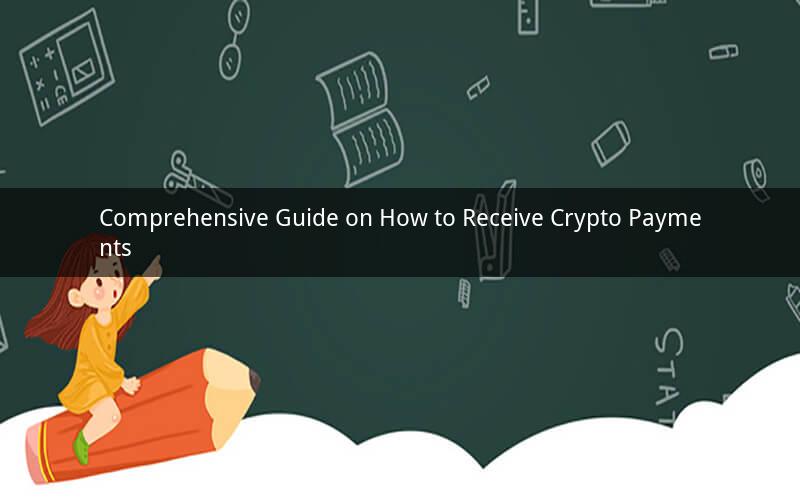
Introduction:
In recent years, cryptocurrencies have gained immense popularity, and more businesses and individuals are accepting them as a legitimate form of payment. Receiving crypto payments can be a convenient and secure way to transact, but it's essential to understand the process. This article will provide a detailed guide on how to receive crypto payments, covering various aspects such as choosing a wallet, setting up an account, and ensuring security.
1. Choosing the Right Cryptocurrency Wallet
When receiving crypto payments, the first step is to select a suitable cryptocurrency wallet. A wallet is a digital storage solution that allows you to send, receive, and store cryptocurrencies. Here are some types of wallets to consider:
a. Hardware wallets: These wallets are considered the most secure, as they store your private keys offline. Examples include Ledger Nano S and Trezor Model T.
b. Software wallets: These wallets are available on your computer or smartphone and can be either mobile or desktop-based. Examples include Exodus, Trust Wallet, and Electrum.
c. Web wallets: These wallets are hosted on a third-party server and can be accessed through a web browser. Examples include Coinbase Wallet and Blockchain.com.
When choosing a wallet, consider the following factors:
- Security: Ensure the wallet offers strong security features, such as two-factor authentication (2FA) and biometric authentication.
- Ease of use: Choose a wallet that is user-friendly and easy to navigate.
- Compatibility: Ensure the wallet supports the cryptocurrency you plan to receive.
2. Setting Up an Account
Once you have chosen a wallet, the next step is to set up an account. Here's how to do it:
a. Download and install the wallet on your device.
b. Create a new wallet by generating a new address. This address will be used to receive payments.
c. Set a strong password and enable 2FA for added security.
d. Optionally, you can backup your wallet's private keys or recovery phrase to restore your wallet in case of loss or damage.
3. Generating a Receiving Address
To receive crypto payments, you need to generate a unique receiving address for each cryptocurrency. Here's how to do it:
a. Open your wallet and navigate to the 'Receive' or 'Receive Funds' section.
b. Select the cryptocurrency you want to receive.
c. Copy the generated address. This address is unique to you and can be shared with others to send payments to your wallet.
4. Displaying Your Receiving Address
To receive crypto payments, you must display your receiving address to others. Here are some ways to do it:
a. Share the address on your website or social media profiles.
b. Include the address in your business card, flyers, or other promotional materials.
c. Send the address to your customers via email or messaging apps.
5. Ensuring Security
Security is paramount when receiving crypto payments. Here are some tips to help you keep your funds safe:
a. Use a strong, unique password for your wallet.
b. Enable 2FA to add an extra layer of security.
c. Regularly update your wallet software to ensure you have the latest security features.
d. Be cautious of phishing attempts and only share your address with trusted individuals or businesses.
6. Confirming Transactions
Once you have received a payment, it's essential to confirm the transaction. Here's how to do it:
a. Check your wallet's transaction history to see if the payment has been received.
b. Verify the transaction details, such as the sender's address and amount.
c. Wait for the network to confirm the transaction. This process can vary depending on the cryptocurrency.
7. Common Issues and Solutions
Here are some common issues you may encounter when receiving crypto payments, along with their solutions:
a. Delayed transactions: If a transaction is taking longer than expected, it may be due to network congestion. Wait for a few hours or try sending a smaller amount.
b. Failed transactions: If a transaction fails, ensure you have entered the correct receiving address and have enough balance in your wallet.
c. Double-spending: Double-spending occurs when a transaction is broadcasted to the network but not yet confirmed. To avoid this, wait for the transaction to be confirmed before sending additional funds.
8. Conclusion
Receiving crypto payments can be a straightforward process with the right knowledge and tools. By choosing the right wallet, setting up an account, generating a receiving address, ensuring security, and confirming transactions, you can securely receive crypto payments and enjoy the benefits of this innovative payment method.
Questions and Answers:
1. Q: Can I receive crypto payments without a wallet?
A: Yes, you can receive crypto payments without a wallet by using a web wallet or a third-party payment service. However, this may expose you to higher risks, such as the possibility of your funds being stolen or frozen.
2. Q: How long does it take to receive a crypto payment?
A: The time it takes to receive a crypto payment can vary depending on the network and the amount of network congestion. Generally, transactions are confirmed within a few minutes to a few hours.
3. Q: Can I receive multiple cryptocurrencies in a single wallet?
A: Some wallets support multiple cryptocurrencies, allowing you to receive different coins in the same wallet. However, this depends on the wallet's compatibility with various cryptocurrencies.
4. Q: What should I do if I receive a payment with the wrong address?
A: If you receive a payment with the wrong address, it's crucial to contact the sender immediately. They may be able to cancel the transaction before it is confirmed on the network.
5. Q: Can I track my crypto payments?
A: Yes, you can track your crypto payments by monitoring your wallet's transaction history or using blockchain explorer websites. This will allow you to see the details of each transaction, including the sender's address and the amount sent.